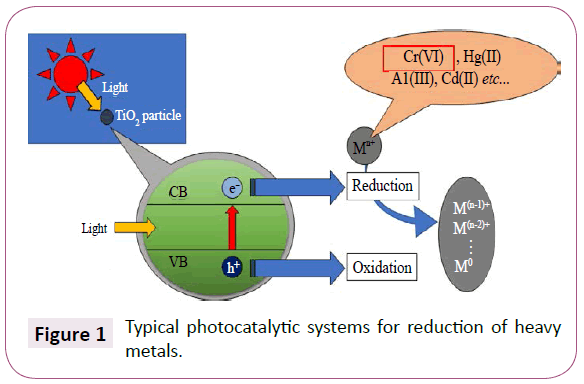Editorial - (2018) Volume 4, Issue 1
About photocatalytic metal complexes for Cr(VI) to Cr(III) reduction reaction
Takashiro Akitsu*
Department of Chemistry, Faculty of Science, Tokyo University of Science, Japan
*Corresponding Author:
Takashiro Akitsu
Professor of Chemistry, Department of Chemistry, Faculty of Science
Tokyo University of Science, 1-3 Kagurazaka, Shinjuku-ku
Tokyo 162-8601, Japan.
Tel: +81-3-5228-8271
Fax: +81-3-5261-4631
E-mail: akitsu@rs.kagu.tus.ac.jp
Received date: August 21, 2018; Accepted date: August 23, 2018; Published date: August 31, 2018
Citation: Akitsu T (2018) About Photocatalytic Metal Complexes for Cr(VI) to Cr(III) Reduction Reaction. Trends Green Chem. Vol. 4 No. 1:2. doi: 10.21767/2471-9889.100022
Copyright: © 2018 Akitsu T, et al. This is an open-access article distributed under the terms of the Creative Commons Attribution License, which permits unrestricted use, distribution, and reproduction in any medium, provided the original author and source are credited.
Editorial
Many industries sometimes emit harmful products for the environment. Hexavalent chromium is regulated, but there are uses that cannot be substituted, mainly used for plating, leather product processing, cement hardening materials and so on. There is also still report of soil contamination of Cr (VI) in Japan all over the country. Thus, the toxicity of chromium compounds predominantly depends on oxidation states of chromium ions, and well-found and stabilized states are Cr (VI) and Cr (III). Solubility and toxicity of Cr (VI) compounds are higher than that of Cr (III) and the latter is usually readily immobilized by precipitation. Thus, reduction of Cr (VI) in the highest valence to Cr (III) has been widely employed as an efficient approach to minimize chromium contamination in the environment (Figure 1). Exposure to various forms of Cr (VI) containing compounds has been consistently found to be associated with an elevated incidence of respiratory cancers and other adverse health damage for human beings. Role of valence state and solubility of chromium compounds on induction of cytotoxicity may be important in this context. Importance of chromium-DNA adducts in mutagenicity and toxicity of Cr (VI) was also pointed out significantly.

Figure 1: Typical photocatalytic systems for reduction of heavy metals.
One of the goals of our projects is to create the effective photocatalysts based on the Schiff base metal complex for Cr (VI) to Cr (III) reduction reaction [1-5]. Our laboratory reported Cr (VI) reduction by methanol, TiO2, and a homogeneous visible light photocatalyst of amino acid Schiff base Cu (II) complexes. We added a polar hydroxyl group on the aromatic ring, and aimed to increase affinity with Cr (VI) aqueous solutions. For example, molecular design and electronic or optical properties correlated typically as follows: no peak shift derived from different amino acid ligands was observed. The π-π* transition (around 350 nm) derived from the ligand shifted to the shorter wavelength side than the complex without hydroxyl group [5], and the peak around 280 nm shifted to longer wavelength side. As known well, photocatalysts can be considered as a promising method because upon irradiation by a certain wavelength light, it can easily and efficiently achieve the desired effect in decomposing harmful compounds. As photosensitizers organic and inorganic compounds can be also used. Recently, we also found that the reaction can occur without TiO2 (only Cu complexes). So, detailed classification of reaction conditions or systems should be required. By the way, some Metal-Organic-Frameworks reported exhibited semi-conductor behavior and photo-induced reduction of Cr (VI) or other chemical reactions. The development of effective photocatalysts based on less toxic and abundant compounds leads to the decrease of the negative impact to the environment and the number of exposed to cancer caused by Cr (VI) compounds.
Nowadays, molecular design by means of theoretical prediction or using big data has been developed rapidly. However, our empirical strategy could be summarized as follows: (1) both the single system and the hybrid system were able to confirm the catalytic ability of chromium reduction by light irradiation. (2) In the case of visible light irradiation, the single system showed better reducing ability and they correspond to the absorption intensity in the visible region of the complex, and the greater the light absorption, the better the efficiency of electron transfer. Furthermore, comparison of calculated and experimental data electrochemical and photochemical properties in systematic rows of coordination compounds will provide the possibility to formulate the proposed mechanism for photocatalytic reduction of Cr (VI) to Cr (III) compounds. In addition, we would like to be given cooperation by data scientist dealing with computational chemical methods.